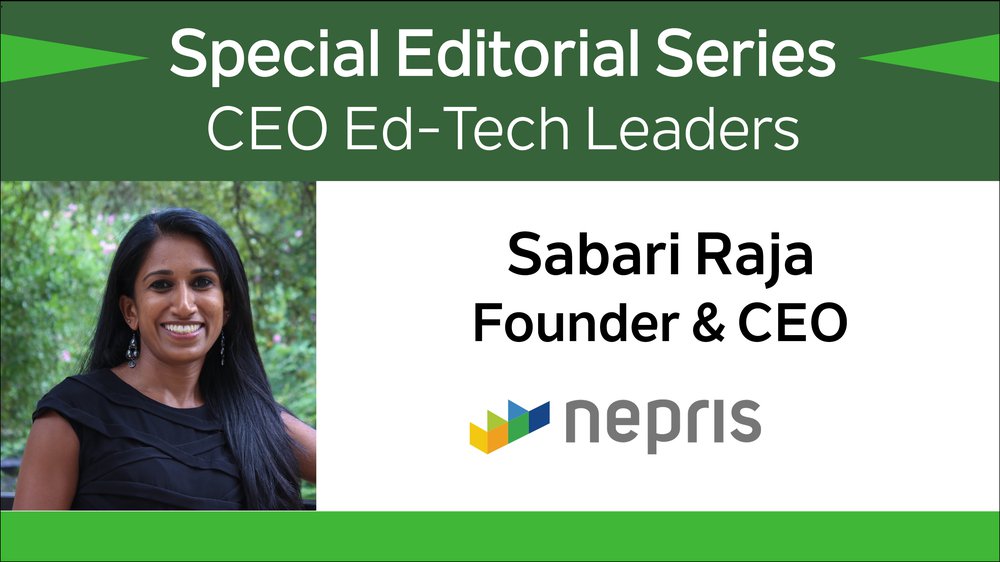Sabari Raja is co-founder and CEO of Nepris Inc, a unique cloud-based platform connecting industry and education to inspire students through real-world connections and career exposure.
With eighteen years in educational technology, Raja speaks passionately about helping students learn by showing application and purpose in their education. She is active in the public sector holding several positions in the educational community such as the Champions board of Texas Girls Collaborative and Friends of Texas Public Schools (FOTPS). She is also a busy mom with two boys in middle school.
“I grew up in a rural area in South India to parents without college degrees. But, the importance of education was instilled in me at a very young age. When I had the opportunity to work in ed-tech, it was meant to be. We built a platform that brings industry and education stakeholders together at a scale not attempted before,” explains Raja. "In a short period, we have over 40,000 educators in the U.S connecting with 25,000 industry experts. Soon we envision this community growing to millions where we impact students around the world.”
Raja and Binu Thayamkery co-founded Nepris with the purpose of helping students answer questions: “Why am I learning linear equations?” and “When and where will I use it?” These questions, when unanswered, cause widespread consequences. Raja refers to the Gates Foundation study “The Silent Epidemic in Education”. The number one reason kids drop out of school is they lack reasons for attending. There are 11 million unemployed Americans, yet 7 million jobs sit unfilled. “This is the skills gap and this gap exists because kids don’t see the relevance of school or have exposure to career possibilities,” explains Raja.
“When a theme-park designer shows how linear equations are applied and when a scientist working for the Bureau of Engraving and Printing demonstrates the chemistry behind printing money, we are bridging the gap between industry and education and are moving the needle towards addressing the workforce pipeline gap,” adds Raja. “Even today with so many advances in technology and learning, traditional school is far removed from the real world. We make kids memorize formulas in math, solve equations in chemistry, dissect frogs in biology, and be deathly afraid of tests.”
She describes her own experience as a student graduating with the right grades, earning an undergraduate degree in Electrical Engineering, Master in Computer Science from LSU, and an Executive MBA from Cox School of Business; SMU “I've done all the things expected of me. But literally, I feel like my personal experience was like: You can wake me up in the middle of the night. I'll tell you how to solve a quadratic equation, but don't ask me why I'm doing that,” says Raja.
The Nepris program begins by allowing a teacher access to the company’s global network of industry experts. With the help of the school district and the appropriate curriculum resources that include technology and training, the teacher and students will benefit in engaging industry professionals in the classroom via video conferencing. Even as early as elementary school education, the connection is available. Cajon Valley Unified is an example of district leaders and teachers working together to integrate “World of Work” resources in K-8 classrooms.
“Companies like AT&T have committed 1 million hours of employee engagement to help bridge the skills gap. Verizon and Ochsner are leading the way as well. While the education climate is changing and there are more states now realizing the importance of business and industry engagement in preparing the future workforce, changing teaching practices across the board is a monumental task,” explains Raja.
Through Raja guidance, Nepris’ team operates on the basis that the top 20% of the most proactive teachers are ready to embrace new models of teaching and learning, but the majority do not have the time or the resources to make this transition. The company meets the teachers in their districts and integrates a platform into their day-to-day curriculum. “So, it’s not one more thing to do on top of everything else,” says Raja.“We offer more targeted professional development that goes beyond product training by doing hands-on workshops showing them how to integrate industry engagement into their lesson plans.”
In Royse City, Texas, a rural classroom connected with a Neurosurgeon in New York. The teacher, Kelly Margot, Gifted Specialist, Royse City ISD, wrote a letter to her superintendent about the success of having a professional speaker in her class via videoconferencing:
“I really think the great equalizer for equity in childhood is experiences. Experiences that bridge the gap to give them opportunities to know what is out there. Nepris is an AMAZING tool that allows us, as educators, to bring experiences with the world into the classroom.
Yesterday, my students were able to talk to a brain expert in New York. Today, a student came in fired up about his next research idea over "Cures for Neurological Issues". The expert told the kids what happens in the brain that causes autism. This kid wants to know what is being done to fix it. I love Nepris. It is transforming my classroom. My students are reaping the benefits. The world will eventually be rewarded by their curiosity.”
Raja recognizes technology is the only way education can bridge the geographic and socio-economic divide. “Many students in rural areas don’t really have much access to a diversity of people and experiences around them.”
Using Nepris technology, students in remote parts of Louisiana experience a virtual tour of the General Motors assembly plant. Another class presents and gets feedback on their projects from a software engineer at Samsung Electronics. “Apart from these virtual role models and experiences students access digital curriculum, videos, and resources from anywhere at any time. It is only possible through Ed-tech. Ed-tech provides equity of access and scalability that is needed to impact all students. Future of Ed-tech is breaking down walls of traditional classrooms, removing geographic barriers and using technology to reach all students,” says Raja.











